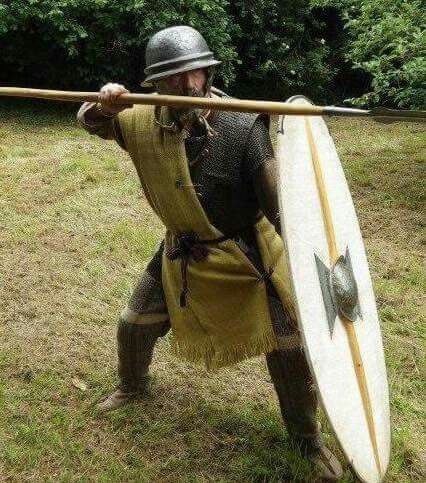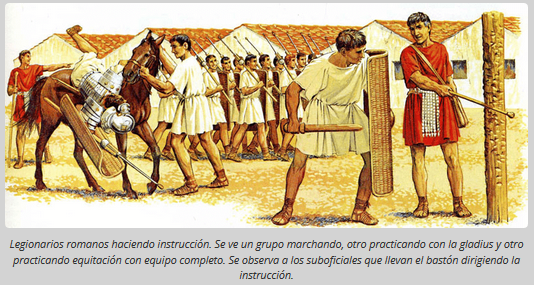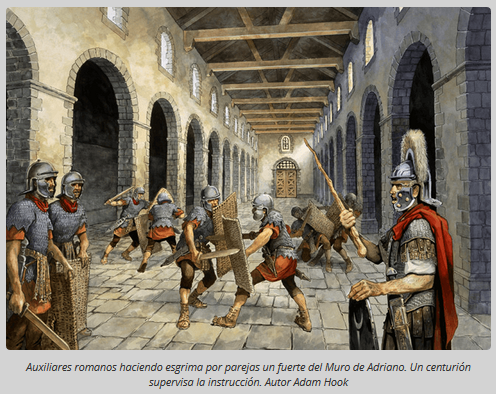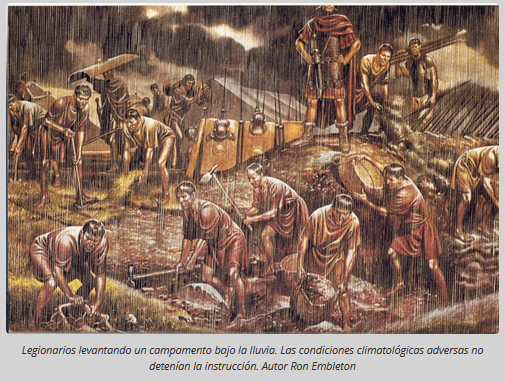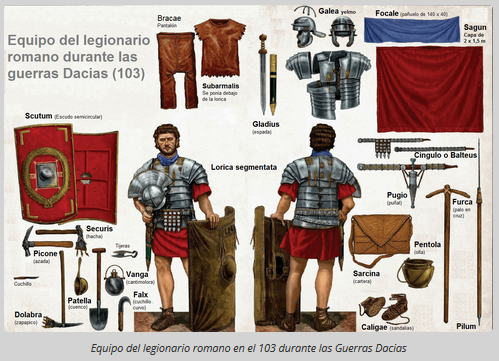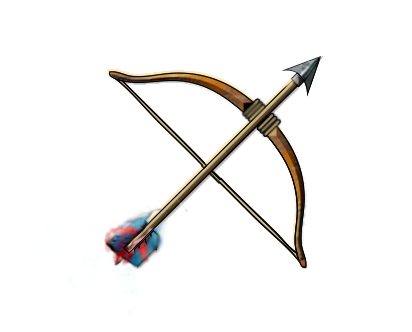-
Posts
25.684 -
Joined
-
Days Won
300
Everything posted by Lion.Kanzen
-
At last an armored horse.
-
.thumb.png.ce58cea22940c255f5b0a735d5abee36.png)
Romans military image references
Lion.Kanzen replied to Lion.Kanzen's topic in Tutorials, references and art help
Officer clothing Start with This ask your question @wackyserious at all. Very extended compilation of roman clothes military and civil. http://saturnales-rev.blogspot.com/2008/09/indumentaria-de-los-personajes.html -
.thumb.png.ce58cea22940c255f5b0a735d5abee36.png)
Romans military image references
Lion.Kanzen replied to Lion.Kanzen's topic in Tutorials, references and art help
Punic war consul. The battle of Trasimene Lake. consul Flaminius https://en.wikipedia.org/wiki/Gaius_Flaminius_Nepos The autor says the consul uses white Pturges -
.thumb.png.ce58cea22940c255f5b0a735d5abee36.png)
Romans military image references
Lion.Kanzen replied to Lion.Kanzen's topic in Tutorials, references and art help
Indeed @Loki1950 is a officer costume He said the kind of band/strip.. in the muscle armor. https://figurasapincel.com/2014/12/ -
.thumb.png.ce58cea22940c255f5b0a735d5abee36.png)
Romans military image references
Lion.Kanzen replied to Lion.Kanzen's topic in Tutorials, references and art help
-
.thumb.png.ce58cea22940c255f5b0a735d5abee36.png)
Romans military image references
Lion.Kanzen replied to Lion.Kanzen's topic in Tutorials, references and art help
-
.thumb.png.ce58cea22940c255f5b0a735d5abee36.png)
Romans military image references
Lion.Kanzen replied to Lion.Kanzen's topic in Tutorials, references and art help
Roman Weapons The Romans were quick to improve upon ideas from other cultures. Early Etruscan arms were based on those of the Greeks. When the early Romans came in contact with the the Gauls, they took their idea for a large oval shield. When they Spanish Celts, they took their idea for a sword and so on. Pilum: The pila (plural form) were quite unique in design. These javelins were designed to warp after impact, so they would drag down an enemy's shield, sometimes pinning two of them together. The average pilun was 1.8 meters long. It had a barbed iron shaft connected to the wooden pole in a weighted socket. A lead ball weight was added to further increase the throwing distance in the late half of the 2nd century AD. Pilum were used until the late empire. Hasta: The hasta was the Roman trusting spear. It was carried by the units called triarii in Republic times. Marius military reforms made the pilum the standard spear carried by all legionaries. Gladius: The Romans patterened their short swords after those of the Spanish Celts. The historian, Polybius, says they were introduced into the army during the second Punic War. This sword was intended as a thrusting weapon. This was the best way to use a sword in tight formation. Using the sword in a slashing motion would cause the soldier to open his side to attack. The gladius was replaced by the traditional long swords of the barbarians in the late empire. The below image is of the Pompeii type. Archaeologists have catagorized these swords into three main types. The oldest, "Mainz" pattern had a blade 20 - 22 in. long, about 2.5 - 3in. wide. The edges curved inward at mid length of the blade. This was the blade carried by the soldiers of Caesar's time up till Tiberius. The later "Fulham" and the "Pompeii" types had edges which were parallel. The Fulham pattern was jus as long as the "Mainz." The blade started slightly wider at the hilt, sloping sharply to a 2 in. width for the rest of the length to the tip. The "Pompeii" had a shorter blade length, 18 - 22 in., was typically 2in. wide, and had completely parallel edges. See photo of a Fulham sword on the British Museum website. Spatha: The was the sword used by the cavalry. The blade was much longer than the galdius and was used for slashing. The large numbers of barbarians serving in the legions used the spatha in the late empire. It was ideal because the spatha did not require the same skill and training needed to properly wield a gladius. Pugio: The legionaries carried a dagger starting in the 2nd or 1st centuries BC. During the rein of Augustus the gladius was carried on one belt and the pugio hung on another. By the 2nd century AD daggers were no longer issued. Lancea: This repalced the pilum as the primary weapon of the 3rd century AD on. It was a thrusting spear. Veruta: This was the throwing javelin of the late empire. Plumbatae or Mattiobarbuli: These were hand-thrown lead weighted darts carried by the infantry. They were rather expensive to produce, but they allowed the infantry to effectively double as missile troops Monday, July 6, 2009 Roman Helmets The armor of Rome felt a strong influence from its neighbors. Early Roman armies displayed helmets similar to those of Greece and Gaul. After Caesar conquered Gaul in the 50s BC, the Roman government employed the very skilled iron smiths of that country to produce the legions' first iron helmets. Consequently, Gallic style became prominant in this Roman equipment. In the later Empire armor was influenced by the Persians and Sarmatians. It should be noted that the names for these helmets are not Roman in origin. Archaeologists named them based on their appearance or where they were first unearthed. In his 1975 book, The Armour of Imperial Rome, H. Russell-Robinson formulated a typology for Roman helmets, which is the standard for helmet discussions to this day. This book is out of print and difficult to find. Fortunately, a synopsis is available on RomanArmy.com I illustrate a few of Robinson’s types bellow. Montefortino Helmet 4th century BC to the 50s AD. The Romans copied this style of helmet from the Gauls and Celt-Iberians. The legions of Julius Caesar’s time would have worn helmets like this. There is an attachment at the top for a horsehair or feather plume. It is named for the find site, the Necropolis at Montefortino, in northern Italy. Typically bronze, the helmets of centurions were often plated in tin. Coolus C Late Augustan to Tiberian period. This type of helmet was very well made. The horizontal ridge along the brow was put in place to prevent sword blows from hitting the main headpiece. It is named afrer the Coolus region of the Marne River valley in present-day France where the first examples were found. Coolus E Late Augustan to Tiberian period. Unlike the Coolus C, this helmet was mounted with side tubes for plumes and a top spike for holding a horse hair crest. This crest would be held in a small metal box, rather than the Republican era method of gathering all the hair at one point like a paintbrush. As more advanced forms of helmet were developed the Coolus was continued to be used by auxiliaries. Imperial Gallic H 1st century AD. The embossed eyebrow pattern at the front of the shull cap displays a Gallic influence, resulting in the name of this family of helmets. The drawing shows a Gallic H, which featured a more sloping neck gaurd then found in previous Gallic types. Imperial Italic G 3rd century AD. The term "Italic" applies to a whole family of Roman helmets all sharing a similar style. They were used at the same time as the Gallic types. A notable difference is the fact that the Gallic embossed eyebrows are missing. Spangenhelm 3rd century AD. (this term, Spangenhelm, is best applied to helmets from the Middle Ages.) Believed to have originally been developed by the Sarmatians, this helmet was relatively easy to produce. It was made of between four and six curved iron plates shaped into a bowl and riveted together by bands or Spangen. Adopted by the Romans in the 3rd century AD, it continued to be used by European armies well into the 7th century. Ridge Helm 4th century AD. This helmet appeared with the end of the production of the Gallic style helmets. It consisted of two curved plates connected by a central ridge. To this cheek pieces, neck guard, and sometimes nose piece were added. Produced in a variety of styles, they were manufactured in huge quantities for infantry and cavalry. By this time the Empire found it more cost effective to reduce the armor of the legions. A helmet and a shield would, on most ocassions, be the only armor a Roman soldier would receive. The style may be from a Persian influence. -
.thumb.png.ce58cea22940c255f5b0a735d5abee36.png)
Romans military image references
Lion.Kanzen replied to Lion.Kanzen's topic in Tutorials, references and art help
Balteus Called balteus early in the empire and then cingulum militare in later times. The mark of a soldier, belts were not meant for civilian use! When worn over chainmail, the belt helped to take some of the weight off the soldier's shoulders. In the first half of the 1st century AD it was common to wear two belts in the army: one to hold the sword and one to hold the dagger. Foot soldiers wore their sword on their right, officers on their left. In the Later Empire, this distinction fell away. The belts were rather narrow and were decorated with metal plates all the way around. The decoration of each bronze plate could be quite ornate. They featured embossed or engraved designs, sometimes plated with tin, and in rare cases coated with silver foil. The engraving sometimes had blue-black niello inlay. During the 1st and 2nd centuries AD the belt supported several vertical strips of metal-studded leather, forming a groin guard. However, judging by the meek protection offered a few dangling pieces of leather and the ornate decoration, it may be that this apron's more important purpose was to portray a man's social status as a soldier. -
.thumb.png.ce58cea22940c255f5b0a735d5abee36.png)
Romans military image references
Lion.Kanzen replied to Lion.Kanzen's topic in Tutorials, references and art help
Lorica Musculata (breastplate) In Rome’s very early history men wore fitted bronze plate armor in the Greek hoplite style. These were well decorated with animal, mythological and chest muscle designs. No Roman examples have been found in excavations, but sculpture shows them being used by officers and emperors well into the 1st century AD. The rectangular strips dangling at the sleeves and waist in this illustration are called pteruges. Made of layered linen (or perhaps leather), they added protection to the upper arms and thighs, while conserving metal. They were probably attached to a cloth arming doublet worn under the armor. http://www.redrampant.com/2009/ See: J.L. Sebesta, L. Bonfante, "Costume as Geographic Indicator: Barbarians and Prisoners on Cuirassed Statue Breastplates" in The World of Roman Costume. Masidon WI. University of Wisconsin Press, 2001. -
-
.thumb.png.ce58cea22940c255f5b0a735d5abee36.png)
Romans military image references
Lion.Kanzen replied to Lion.Kanzen's topic in Tutorials, references and art help
-
.thumb.png.ce58cea22940c255f5b0a735d5abee36.png)
Romans military image references
Lion.Kanzen replied to Lion.Kanzen's topic in Tutorials, references and art help
Cingulum, a kind of belt, but isn't strict a thing I mean, is the name to belt @wackyserious -
.thumb.png.ce58cea22940c255f5b0a735d5abee36.png)
Romans military image references
Lion.Kanzen replied to Lion.Kanzen's topic in Tutorials, references and art help
-
.thumb.png.ce58cea22940c255f5b0a735d5abee36.png)
Romans military image references
Lion.Kanzen replied to Lion.Kanzen's topic in Tutorials, references and art help
Samno Attic -
.thumb.png.ce58cea22940c255f5b0a735d5abee36.png)
Romans military image references
Lion.Kanzen replied to Lion.Kanzen's topic in Tutorials, references and art help
They represent the helmet in a greek fhasion. similar to Thracian Atticus. -
.thumb.png.ce58cea22940c255f5b0a735d5abee36.png)
Romans military image references
Lion.Kanzen replied to Lion.Kanzen's topic in Tutorials, references and art help
Dong forget these The guy on left... -
.thumb.png.ce58cea22940c255f5b0a735d5abee36.png)
Romans military image references
Lion.Kanzen replied to Lion.Kanzen's topic in Tutorials, references and art help
Look that... -
.thumb.png.ce58cea22940c255f5b0a735d5abee36.png)
Romans military image references
Lion.Kanzen replied to Lion.Kanzen's topic in Tutorials, references and art help
This very old Lorca musculata -
.thumb.png.ce58cea22940c255f5b0a735d5abee36.png)
Romans military image references
Lion.Kanzen replied to Lion.Kanzen's topic in Tutorials, references and art help
The high range is very debatable the equipment.we saw this with The helmet Amicus But legionnaires have more "standard" -
.thumb.png.ce58cea22940c255f5b0a735d5abee36.png)
Romans military image references
Lion.Kanzen replied to Lion.Kanzen's topic in Tutorials, references and art help
Is not linothorax is Lorica Musculata. Is armor for high ranges or elite units. Here Nero and Agrippina -
.thumb.png.ce58cea22940c255f5b0a735d5abee36.png)
Romans military image references
Lion.Kanzen replied to Lion.Kanzen's topic in Tutorials, references and art help
I'm not sure put is part of many statues of roman emperors(or consuls) Gaius Julius Caesar -
-
Yeah its only the start. for me is part of method.
-
.thumb.png.ce58cea22940c255f5b0a735d5abee36.png)
Romans military image references
Lion.Kanzen replied to Lion.Kanzen's topic in Tutorials, references and art help
But romans Consuls(Heroes) all they are the same. I can make a portrait, because they aren't accurate at all.




